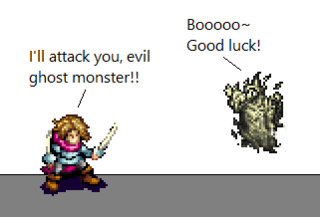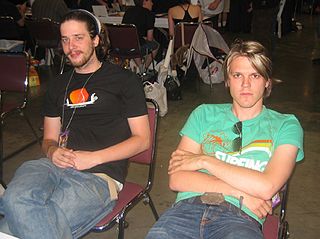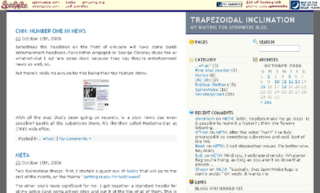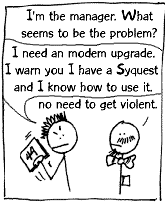
User Friendly is a webcomic written by J. D. Frazer, also known by his pen name Illiad. Starting in 1997, the strip was one of the earliest webcomics to make its creator a living. The comic is set in a fictional internet service provider and draws humor from dealing with clueless users and geeky subjects. The comic ran seven days a week until 2009 when updates became sporadic, and since 2010 it has been in reruns only.

Sprite comics are webcomics that consist primarily of computer sprites from video games. Art assets are ripped from various classic games such as Mega Man and Sonic the Hedgehog, are edited and combined by amateur cartoonists, and are posted on the internet. Popularized by Bob and George in the early 2000s, the style is considered relatively easy for beginning cartoonists to get involved in, but sprite comics are generally looked down upon for being of low quality.
Publication of comic strips and comic books focusing on science fiction became increasingly common during the early 1930s in newspapers published in the United States. They have since spread to many countries around the world.
A Modest Destiny is a pixel art webcomic created by Sean Howard. The comic started in January 2003 and ran until 2010. It consists of four chapters and one side story.
Dinosaur Comics is a constrained webcomic by Canadian writer Ryan North. It is also known as "Qwantz", after the site's domain name, "qwantz.com". The first comic was posted on February 1, 2003, although there were earlier prototypes. Dinosaur Comics has also been printed in three collections and in a number of newspapers. The comic centers on three main characters, T-Rex, Utahraptor and Dromiceiomimus.

Little Gamers is a webcomic made by Christian Fundin and Pontus Madsen. It began on December 1, 2000.

Keenspot is a webcomics portal founded in March 2000 by cartoonist Chris Crosby, Crosby's mother Teri, cartoonist Darren Bleuel, and Nathan Stone.

Doctor Fun is a single-panel, gag webcomic by David Farley. It began in September 1993, making it one of the earliest webcomics, and ran until June 2006. Doctor Fun was part of United Media's website from 1995, but had parted ways by 2003. The comic may have been the longest-running webcomic before it concluded, having run for nearly thirteen years with over 2,600 strips. The webcomic has been compared to The Far Side.
Matt Feazell is an American cartoonist from Hamtramck, Michigan, primarily working in minicomics. He is best known for his wryly humorous The Amazing Cynicalman series and the simple "stick figure" art style he uses for it. Cynicalman appears in the introduction to Scott McCloud's book Understanding Comics, in which Feazell's work is cited as an example of "iconic" art taken to its greatest degree.

The Order of the Stick (OOTS) is a comedic webcomic that satirizes tabletop role-playing games and medieval fantasy. The comic is written and drawn by Rich Burlew, who illustrates the comic in a stick figure style.

Scary Go Round is a webcomic by John Allison. Running from 2002 to 2009, it is set in the fictional North Yorkshire town of Tackleford and follows university students battling fantasy and science fiction threats to the town. The comic was a successor to Allison's first comic, Bobbins, and was followed by Bad Machinery, all of which take place in the same general setting.
Rich Burlew is an American author, game designer, and graphic designer. He is best known for The Order of the Stick webcomic, for which he was ranked fifth on ComixTalk's list of the Top 25 People in Webcomics for 2007. He has also written several works for Wizards of the Coast's role-playing game Dungeons & Dragons. He owns and operates a small press publishing company, Giant in the Playground, which he formed to publish his comic work.

SpinnWebe was the personal website of Greg Galcik, also known as "spinn." It gathered the most fame as the home of the Dysfunctional Family Circus, which ran in the late 1990s. Additionally, the site was the showcase for a number of Galcik's other projects, which generally had interactive humor as the unifying theme; in this respect, it anticipated the development of later sites such as Fark and Something Awful. The name SpinnWebe comes from an infamously bad machine translation of the German word for "spider web."

Cyanide & Happiness (C&H) is a webcomic created by Rob DenBleyker, Kris Wilson, Dave McElfatrick and Matt Melvin. The comic has been running since 2005 and is published on the website explosm.net along with animated shorts in the same style. Matt Melvin left C&H in 2014, and several other people have contributed to the comic and to the animated shorts.
The history of webcomics follows the advances of technology, art, and business of comics on the Internet. The first comics were shared through the Internet in the mid-1980s. Some early webcomics were derivatives from print comics, but when the World Wide Web became widely popular in the mid-1990s, more people started creating comics exclusively for this medium. By the year 2000, various webcomic creators were financially successful and webcomics became more artistically recognized.

In contrast with mainstream American comics, webcomics are primarily written and drawn by women and gender variant people. Because of the self-published nature of webcomics, the internet has become a successful platform for social commentary, as well as lesbian, gay, bisexual, and transgender (LGBT) expression.
Matthew Melvin Schultzman, better known as Matt Melvin, is an American cartoonist and writer. He is known for his work on Cyanide & Happiness and his fantasy novel The Leeches Loom.
Sanitary Panels is an Indian webcomic by artist Rachita Taneja. Taking a distinct feminist angle, Sanitary Panels comments upon social justice topics ranging from discrimination to victim blaming. Taneja started her webcomic on Facebook in June 2014 and has since accumulated over 150,000 followers across social media platforms.









